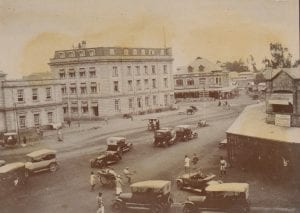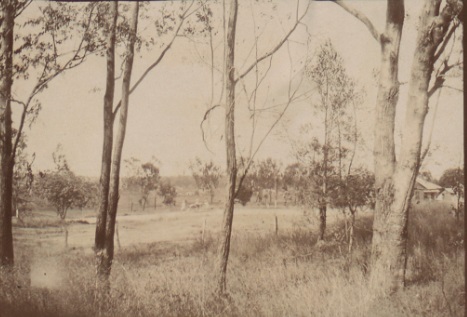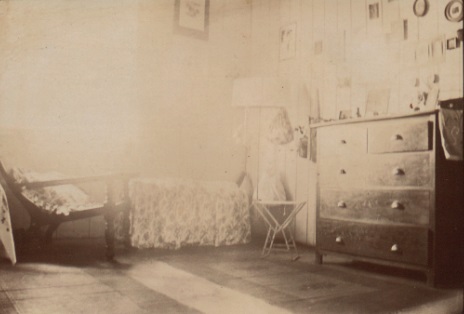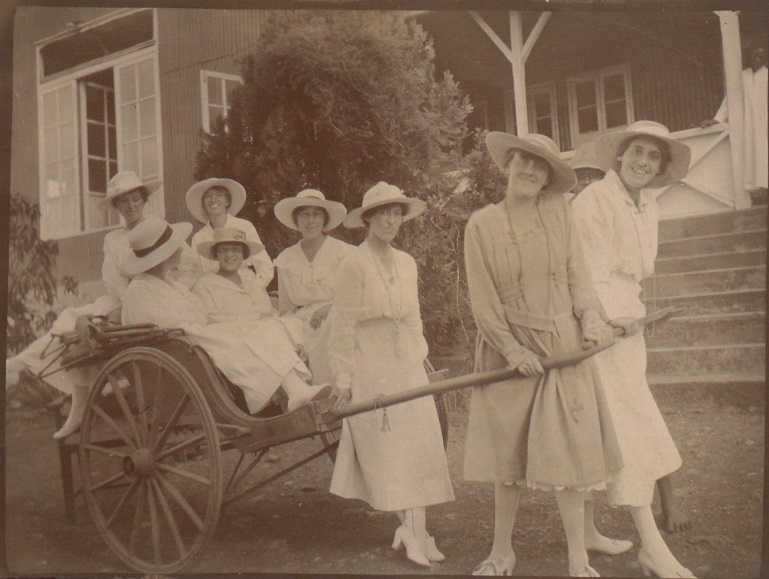Margaret Duncan’s diary: 1st April 1918
Posted on by Fay Curtis.
by Nicky Sugar, Archivist at Bristol Archives
In February 1918 Margaret Duncan, a Post Office clerk from Scotland, sailed to East Africa for a new job and new adventures. Her diary and photograph albums are now in the British Empire and Commonwealth Collection at Bristol Archives (ref: 2001/090/2). One hundred years on, we share her story for the first time.
Last month Margaret explored Zanzibar, the last stop on her ‘topping’ 10 week tour up the coast of Africa. In this instalment, she finally docks in Mombasa, and takes the train to Nairobi with her Post Office colleagues.
My diary
Nairobi
1 April 1918

Central Nairobi, 1918
Nairobi at last, I’m sitting in the Bungalow now and must just review the past few days, the railway journey, the arrival and subsequent settling. The old Cluny arrived in Kilindini harbour on Friday morning early, we were interviewed by an Official who got the signatures of the eight of us, afterwards Mr Pearson the Postmaster of Mombasa came aboard.
No train to Nairobi that day – shock number one. All hotels full – shock number two. We got a bigger shock in the evening when we heard that there was no room for us on Saturday’s train! We raved about, were so disgusted with having to stay an extra day on the Cluny and the Stewards and Stewardesses were horrid to us, they had been getting nastier and nastier as we drew nearer Kilindini.

The view from Margaret’s room
Mr Jessop was a proper sport, saw us all safely through the Customs and of course we just relied upon him for everything with his knowledge of Swahili.
We journeyed twice to the Customs that day, having to return to the Cluny for lunch – and incidentally a lot of cheek. At night it was rather comical, how we all raged and determined to leave the boat and seek rooms anywhere if we had to wait for another train, and how we’d fight the Government!

Margaret’s room in the PO Bungalow, with the homemade covers for boxes clearly visible
Next morning we left and found that our berths were booked right enough, we were bundled into taxis by Mr Jessop and packed off to the Immigration Office, then Mombasa station to see to our luggage. We got a great sendoff at noon, the departure of the train is a great event at Mombasa. We were in first class carriages together, four in each, it must have been because there was no second class accommodation available, so we scored after all.
The journey up was strange, rushing out at certain stations for meals, jogging along at a snail’s gallop, rocking and jolting through jungle and waste land, stopping at wayside stations where only a few natives were visible wearing blankets and carrying native spears. No towns lie between Mombasa and this, the land is wild and bare and uncultivated, a vast game preserve.

Margaret (at the front, dressed in white) and her colleagues outside the Post Office Bungalow in Nairobi
There were herds of Zebra and of Springbok, many Ostriches and great Giraffes a d Buffalos to be seen from the train, but we didn’t see a lion!
At last we got into Nairobi station and were met by Mr Dyer our supervisor.
I like the Bungalow and think I’ll like the life A.1. More anon. Have been making my room homelike today and it’s looking so nice I’ve been rushing the others in by turns to see it.
It’s strange but true that I’m the first of the eight to get my room put right. Mother and Jean made me covers for boxes and things like that, Miss Low here lent me her machine to run up curtains and I was in luck’s way all round as usual. We start work tomorrow.
__
Next month Margaret spills the beans on her new life in the Post Office Bungalow – full of social events, new friends and more soldiers!
Did you know? The railway journey from Mombasa to Nairobi
The Uganda Railway (named after its final destination, although most of the track lay in British East Africa as Kenya was then known) was built between 1896 and 1901. Nearly all the workers who built the railway were from British India, and large numbers of them died during its construction. As it was the only way of reaching the country’s interior from the coast, the long railway journey which Margaret took featured prominently in many people’s first impressions of Kenya, its landscapes and wildlife.